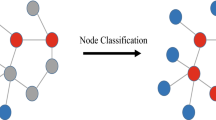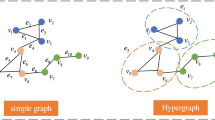Abstract
Graph Convolutional Networks (GCNs) recently have been adopted in several feature representation studies for different classification tasks. While many of these methods are used to work with irregular structure data, they are rarely used to learn regular structure data. It is crucial to construct an excellent graph representation to traditional classification tasks for obtaining the sufficient data representation, including attribute representation and relative representation. In this context, we propose a novel method to construct a reasonable graph representation by capturing the relations in low dimensional space among the data. In order to get the well-represented, we introduce the low-rank constraint and L2-norm regularization to the graph learning framework simultaneously. Experiments demonstrate that the proposed method to learn graph representation is helpful for classification task, and leads to improved performance when compared to state-of-the-art graph learning methods on twelve data sets.




Similar content being viewed by others
References
Blei DM, Ng AY, Jordan MI (2003) Latent dirichlet allocation. J Mach Learn Res 3(Jan):993–1022
Bo J, Lin D, Tang J, Luo B (2019) Data representation and learning with graph diffusion-embedding networks. In: 2019 IEEE/CVF Conference on Computer vision and pattern recognition (CVPR)
Bo J, Zhang Z, Lin D, Tang J, Luo B (2019) Semi-supervised learning with graph learning-convolutional networks. In: Proceedings of the IEEE conference on computer vision and pattern recognition, pp 11313–11320
Bruna J, Zaremba W, Szlam A, LeCun Y (2013) Spectral networks and locally connected networks on graphs. arXiv:1312.6203
Burges CJC (2010) Dimension reduction: A guided tour. Now Publishers Inc
Chung Fan RK, Graham FC (1997) Spectral graph theory. Number 92 American Mathematical Soc.
Defferrard M, Bresson X, Vandergheynst P (2016) Convolutional neural networks on graphs with fast localized spectral filtering. In: Advances in neural information processing systems, pp 3844–3852
Duvenaud DK, Maclaurin D, Iparraguirre J, Bombarell R, Hirzel T, Aspuru-Guzik A, Adams RP (2015) Convolutional networks on graphs for learning molecular fingerprints. In: Advances in neural information processing systems, pp 2224–2232
Fan K (1949) On a theorem of weyl concerning eigenvalues of linear transformations i. Proc. Natl. Acad. Sci. U.S.A. 35(11):652
Hammond DK, Vandergheynst P, Gribonval R (2011) Wavelets on graphs via spectral graph theory. Appl. Comput. Harmon. Anal. 30(2):129–150
Hinton G, Deng L, Yu D, Dahl GE, Mohamed A-r, Jaitly N, Senior A, Vanhoucke V, Nguyen P, Sainath TN, et al. (2012) Deep neural networks for acoustic modeling in speech recognition: The shared views of four research groups. IEEE Signal Process Mag 29(6):82–97
Hu R, Zhu X, Zhu Y, Gan J (2020) Robust svm with adaptive graph learning. World Wide Web 23:1945–1968
Jiang B, Zhang Z (2020) Robustgcns: Robust norm graph convolutional networks in the presence of node missing data and large noises
Kingma DP, Ba J (2014) Adam: A method for stochastic optimization. Computer Ence
Kipf TN, Welling M (2016) Semi-supervised classification with graph convolutional networks. arXiv:1609.02907
Krizhevsky A, Sutskever I, Hinton GE (2012) Imagenet classification with deep convolutional neural networks. In: Advances in neural information processing systems, pp 1097–1105
Le QV, Zou WY, Yeung SY, Ng AY (2011) Learning hierarchical invariant spatio-temporal features for action recognition with independent subspace analysis. In: CVPR 2011. IEEE, pp 3361–3368
LeCun Y, Bottou L, Bengio Y, Haffner P (1998) Gradient-based learning applied to document recognition. Proc. IEEE 86(11):2278–2324
Liu H, Yu L (2005) Toward integrating feature selection algorithms for classification and clustering. IEEE Trans Knowl Data Eng 17(4):491–502
Miller GL, Teng SH, Thurston W, Vavasis SA (1997) Separators for sphere-packings and nearest neighbor graphs. J ACM
Monti F, Boscaini D, Masci J, Rodolà E, Svoboda J, Bronstein MM (2016) Geometric deep learning on graphs and manifolds using mixture model cnns
Nie F, Wang X, Huang H (2014) Clustering and projected clustering with adaptive neighbors. In: Proceedings of the 20th ACM SIGKDD international conference on knowledge discovery and data mining, pp 977–986
Nie F, Wang X, Jordan MI, Huang H (2016) The constrained laplacian rank algorithm for graph-based clustering. In: Thirtieth AAAI conference on artificial intelligence
Nie F, Zhang R, Li X (2017) A generalized power iteration method for solving quadratic problem on the stiefel manifold. Science China Information Sciences 60(11):112101
Sermanet P, Chintala S, LeCun Y (2012) Convolutional neural networks applied to house numbers digit classification. In: Proceedings of the 21st international conference on pattern recognition (ICPR2012). IEEE, pp 3288–3291
Shen HT, Zhu Y, Zheng W, Zhu X (2020) Half-quadratic minimization for unsupervised feature selection on incomplete data. IEEE transactions on neural networks and learning systems, https://doi.org/10.1109/TNNLS.2020.3009632
Taylor GW, Fergus R, LeCun Y, Bregler C (2010) Convolutional learning of spatio-temporal features. In: European conference on computer vision. Springer, pp 140–153
Wold S, Esbensen K, Geladi P (1987) Principal component analysis. Chemometrics and Intelligent Laboratory Systems 2(1-3):37–52
Zhu X, Gan J, Lu G, Li J, Zhang S (2020) Spectral clustering via half-quadratic optimization. World Wide Web 23:1969–1988
Zhu X, Zhang S, Zhu Y, Zhu P, Gao Y (2020) Unsupervised spectral feature selection with dynamic hyper-graph learning. IEEE Trans Knowl Data Eng, https://doi.org/10.1109/TKDE.2020.3017250
Acknowledgements
This work is supported by Innovation Project of Guangxi Graduate Education, Basic Competence Promotion Project for Young and Middle-aged Teachers in Guangxi Education Department (No. 2017KY0176), Research Fund of Guangxi Key Lab of Multi-source Information Mining & Security (No. MIMS19-M-02), Key Laboratory of Software Engineering in Guangxi University for Nationalities (No.2019-18XJSY-03), National Natural Science Foundation of China under Grant No. 62062011, Guangxi Natural Science Foundation under Grant No. 2017GXNSFAA198008 and Open Fund Grant No. GXIC20-06 of Guangxi Key Laboratory of Hybrid Computation and IC Design Analysis.
Author information
Authors and Affiliations
Corresponding authors
Additional information
Publisher’s note
Springer Nature remains neutral with regard to jurisdictional claims in published maps and institutional affiliations.
Beixian Zhang and Meiling Liu had equivalent contribution to this work.
Rights and permissions
About this article
Cite this article
Zhang, B., Liu, M., Zhou, B. et al. Graph learning in low dimensional space for graph convolutional networks. Multimed Tools Appl 81, 34263–34279 (2022). https://doi.org/10.1007/s11042-021-11033-5
Received:
Revised:
Accepted:
Published:
Issue Date:
DOI: https://doi.org/10.1007/s11042-021-11033-5




